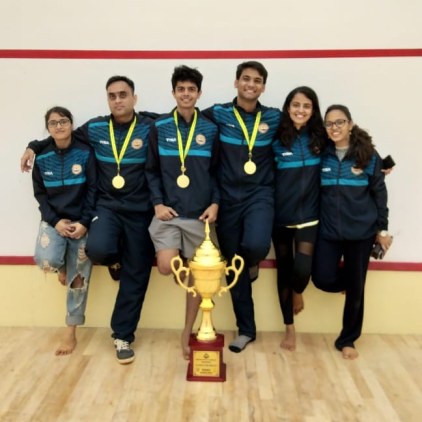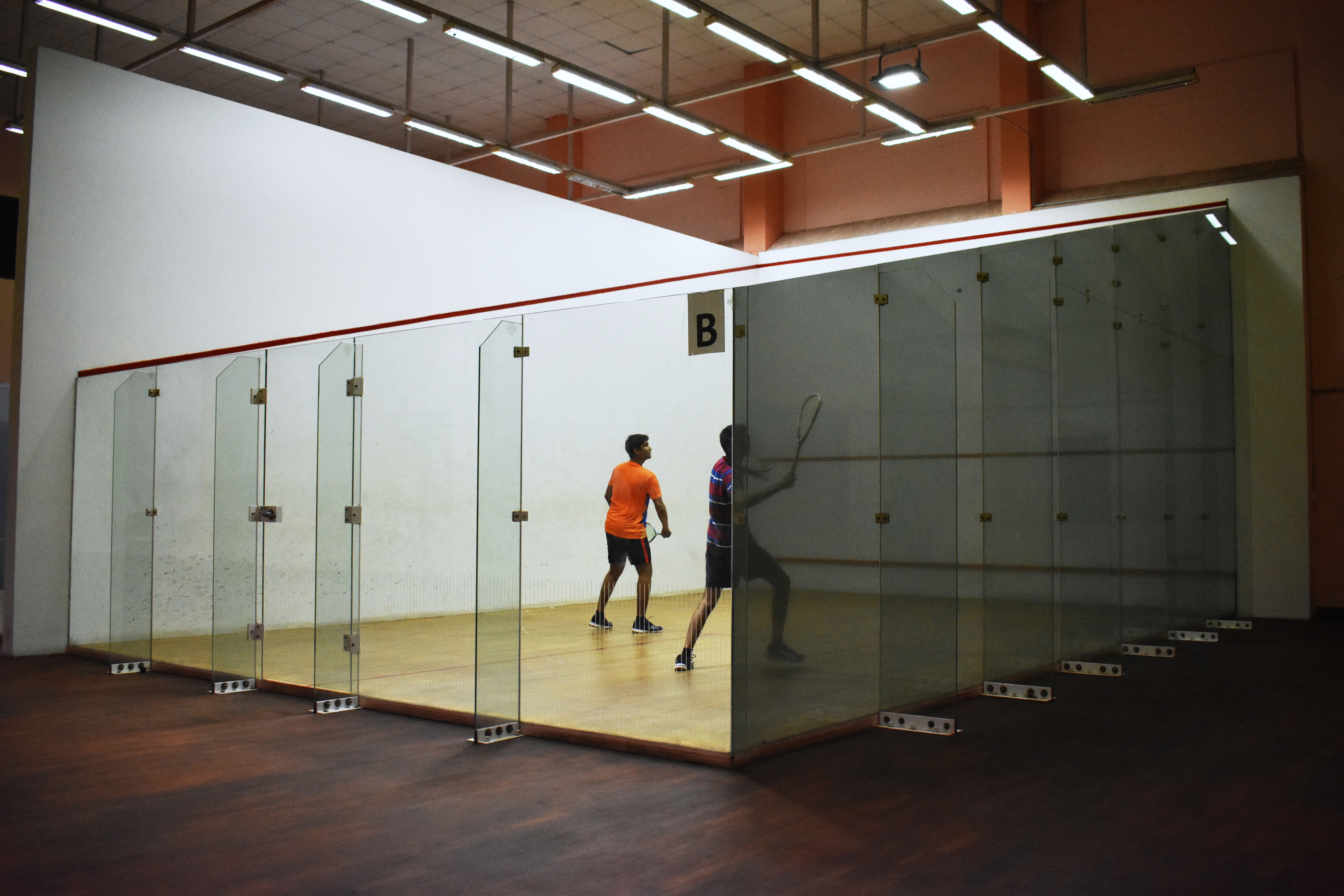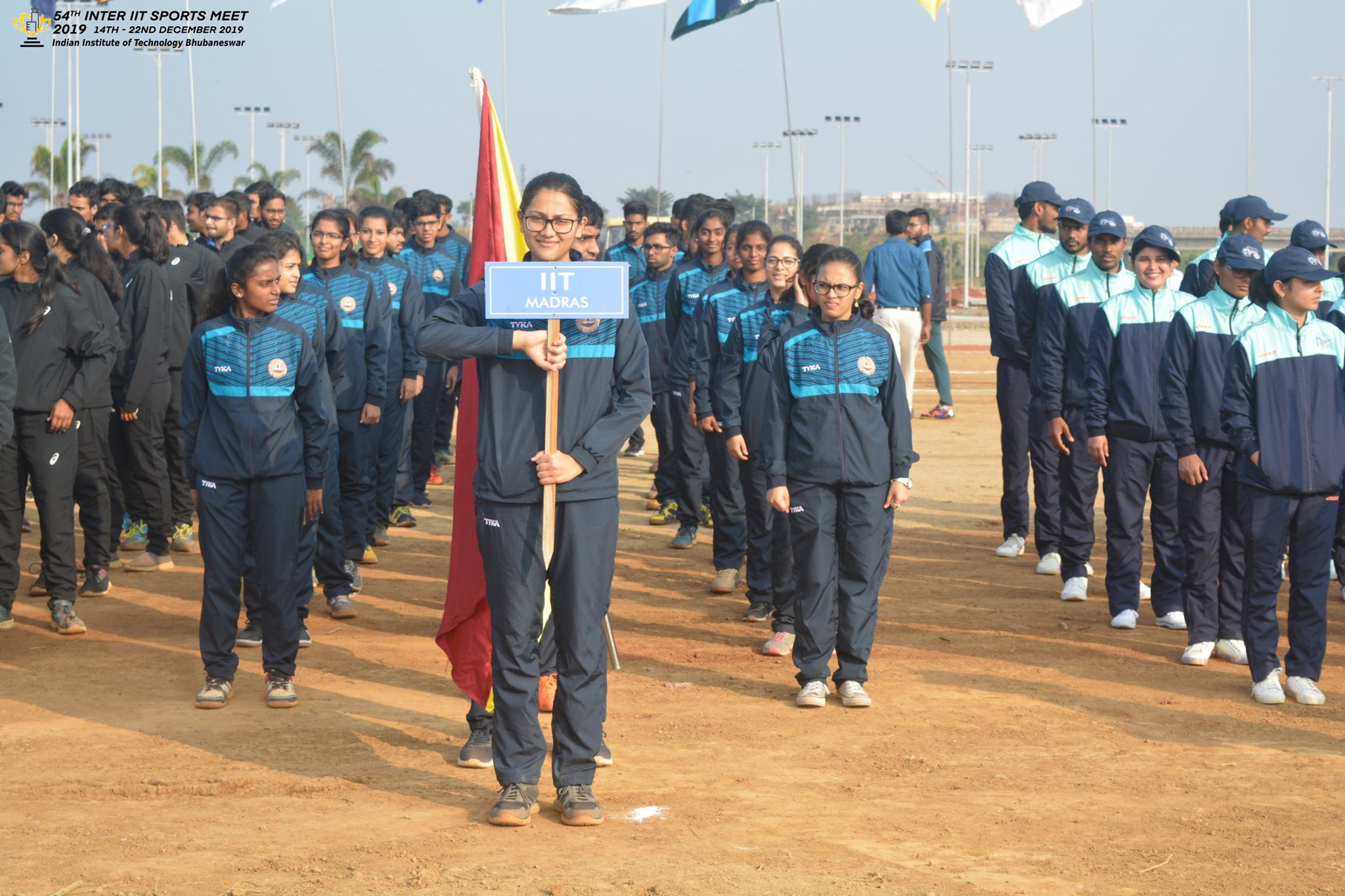While all of us are confined to four walls, our very bored-at-home correspondent, Adriza, is reminded of a sport played inside four walls. Read on as she recounts the institute squash team’s journey on their brilliant showing at the Inter-IIT Sports Meet 2019 and interviews the journeymen.
Warning: Please don’t try this at home.
Shubham demonstrates a popular solo drill in squash – ‘the figure of 8’.
From the outside, the squash court looks like it could be the entrance to just another room in the gymkhana. High ceiling. Bright lights. Walled courts with a glass entrance. People waiting for their turn to play. Someone hogging the floor fan on the side. The frequent bangs of the squash ball hitting the court wall. If you’d like a bird’s eye view of the courts, climb up to the viewing gallery on the third floor. In insti though, you can watch the matches easily on ground level.

Squash is known for long rallies during the match since there isn’t a lot of distance for the ball to cover.
Unlike other racquet sports, you can’t come out of the court once the match begins. The only recovery time you get is by slowing the ball down, or making your opponent run around the entire court.
To do either of the two, you should demonstrate a lot of ball control and quick thinking, besides being able to reach it on time. The ball is something special. It is hard when it’s cold – and it doesn’t bounce. So you need to warm up the ball, along with your muscles, if you have any intention of playing with it!
Holding the racquet in your hand, its design would feel somewhere in between that of badminton and tennis raquets.
At first glance, its width to length ratio is lower than that of tennis, but higher than badminton. Squash racquets usually have droplet shaped heads, tending towards triangular oval. “When I held the racquet for the first time, it just felt right. Not too heavy and wide like the tennis racquet, not too thin and light like badminton,” says Shubham, who has been playing squash since 2012. “I began playing squash because my sister used to. She would tell me about the game and the strategies and it appealed to me. I ended up choosing squash over swimming and I have been at it ever since.”
Varun, on the other hand, chose squash because no matter how hard he hit the ball, it would have to stay inside the court. “I loved playing tennis in school, but when I used too much power, it would go off court. So I switched to squash. I began winning tournaments in it. I believe there’s no point playing a sport if you can’t win matches. It’s pretty simple for me – I play squash because I can win.“
Known for his ceaseless attacks, Varun will leave you frustrated on the court with low hits, just as hard as they are fast. Having been a part of the inter-IIT squash team for 3 years, and the squash captain in his second year, he claims that inter-IIT is what got him hooked on to squash in insti. “I remember one of my factory professors, who was from IITD, telling us about Inter-IIT sports meet. He said first years don’t usually make it to the team. I decided to prove him wrong and make it to the team in my first year itself, just out of spite,” he grins.
Recalling his first semester, he tells us that he would come to the court as soon as his class got over and keep practicing till the courts closed.
“Squash was my anchor as I was settling down into the institute. I would call up Vignesh, the then captain, and annoy him into coming early for practice.” Varun has been in the team since his first year, and has been in love with being a part of the inter-IIT contingent every year since. “There’s no greater feeling when over 160 people come together for one emotion- to compete and win. You’re an equal to everyone there- seniors or juniors- you’re all teammates, playing for insti. I can’t describe the feeling when insti peeps whom you’ve never met before come to cheer you on for the game and insti.“

Last year, the girls squash event was held for the first time in inter-IIT sports. Shubham, the squash captain for 2019-20, was almost single-handedly responsible for coaching the girls team. With the coach injured, someone had to step up and take up the mammoth task of shortlisting, creating, and coaching the girls squash team.
“I hadn’t planned on coaching other players at all, but the institute needed a girls team before the sports meet and I wasn’t ready to let us go empty handed,” says Shubham.
And thus began months of reaching out to previous NSO squash girls, along with spreading the news about the institute girl’s squash team. “I would get texts from new numbers almost everyday, asking me if they could join the practice sessions. Now that I think back, how we managed to regulate the time and space for practice sessions is a wonder,” he says.
As word spread, more and more girls began joining the practice sessions. Time passed by, and only those who showed promise and potential were left. As the days of mini camp rolled around the corner, practice became gruelling and the training was intense. Since all the girls were just beginners, they were almost at the same level, unless of course, they had had prior experience with racquet sports. Sahithi, who became the captain for the women’s first inter-IIT squash team, confesses it was her desire to play in the sports meet that made her switch from tennis to squash. “My strength”, that she attributes to her playing tennis previously, “helped me to hit a cross court volley drop to receive tough serves.” A volley drop is a straight downwards hit, pointed at one of the corners of the front court; it’s a finishing stroke and is very difficult to pick up. Navodita, who switched from badminton to squash, realised there was a lot of competition in badminton, “I figured I could have a better shot at being a part of the inter-IIT squash team than badminton, so squash was the natural choice.” Navodita, who hadn’t set foot in a squash court before joining the team, managed to use her experience at baddy to excel.
Practice during main camp was very different for boys and girls. While the guys worked on their strong suits, the girls had to build theirs almost from scratch.
Team practice during main camp was 3 hours, twice a day and there was no scope to slack off. Shubham was doing double time, coaching the girls and taking time out to work on himself. From teaching serves to match tactics, he focused on their strong skills and made use of their experience with their respective racquet sports.
Being a seasoned player of squash, Shubham, has all kinds of tricks up his sleeve. His deceptions would make you run one way and the ball another. “Squash was a haven for me in my first semester, the only place which echoed familiarity. I would desperately wait till classes were done for the day and I would head over to the courts. I didn’t need anyone to play with, so I would practice for hours on end. It gave me space to process my day and this new place I was in.” He recalls being an instant entrant into the insti squash team in his first year,
“I have been playing squash for over 7 years now, and it is still as important to me as anything else. Even when my school courts closed down, I would bunk classes to play squash. It helped me find my footing; it was something I needed to vent out my frustration.”
Having been formally coached before coming to insti, and with plenty of exposure in the sport, he knew how to train them adequately. The whole team acknowledges his contribution in building the girls team from scratch. “Shubham knew how to get us to win points even though we were just beginners,” explains Sahiti, “he made us do specific drills where we could make our strokes shine and wouldn’t need to learn a lot of new techniques. Most of our strokes are a hybrid; we borrow what we like and adapt it to squash. Since I played tennis, I am more used to hitting strong forehand shots than backhand. For inter-IIT, we focused more on placing the ball in the right places, where we knew it would be hard for the opponent.”

Navodita, on the other hand, is more comfortable with her backhand. “I tend to swing the racquet in a similar way as with badminton,” she goes on, “I can hit good straight length volleys. Shubham made me practice drills such that I would hit them as close to the wall as possible, so it’s difficult for the opponent to pick it up. Since I used a similar stroke in badminton, I didn’t need to learn new techniques and I focused more on the game ahead. We stuck to the techniques we were familiar with and that got us through most of the matches. One of the reasons for reaching the semifinals was our strong services. We didn’t feel very tired after the matches either since we would win four to five points right off the bat because of it.”
When asked about his love for the sport, Shubham tells us that it was one of those things that feels tailored just for him. Squash is his comfort, and his ambition. “One of the reasons I stuck to squash is, no matter how sweaty, tired or thirsty you are, you aren’t allowed to go out of the court while your match is on. So the match is entirely dependent on you from start to finish. How you regulate your energy is most important, since the rallies may go on for quite long compared to other racquet sports. Over time, I realised other things that make a difference. Mastering the technique to change the pace of the match to what you’re comfortable with, exhibits the control you can have over the ball. And the more control you have over the ball, the more control you have over winning the match.”
Not only did he coach the women’s team to semi-finals last year, but he also led the men’s team to win gold for the first time in the history of the institute.
Over the years, the men’s team has won several silvers and bronzes, but this year, with a team packed with skill and a little luck, they conquered what had only been a dream ever since squash became a part of inter-IIT sports meet. The course of the journey of inter-IIT, facing the highs and lows, the wins and losses, excitement and regret, has brought the team close. Varun remarks, “You meet people whom you would otherwise not have met. The one thing that brought all of us together was the spirit to win. Inter-IIT is a place where you will definitely forge bonds that would last beyond your days in the institute.”

The 2019-2020 Inter IIT Squash Team: (L-R) Gaurangi, Avinash, Varun, Shubham, Navodita and Sahithi.
Executive Editor’s Note: On Varun’s behest, we include this snippet to ‘set the record straight’ . A few years ago, all the teams in the institute adopted team ‘names’ so to speak. For instance, most students know that the football team is referred to as the Wolves. Similarly the Squash team are known as the Hawks. If this sounds vaguely familiar to you, you’re onto something because the institute tennis team are the Warhawks. When asked if that was an intentional play on words by the sister racquet sports, Varun clarifies, “We have always been hawks since 2014. Last year they couldn’t find a name so they were like warhawks. Hawk is an animal, warhawk is a rip off.“




